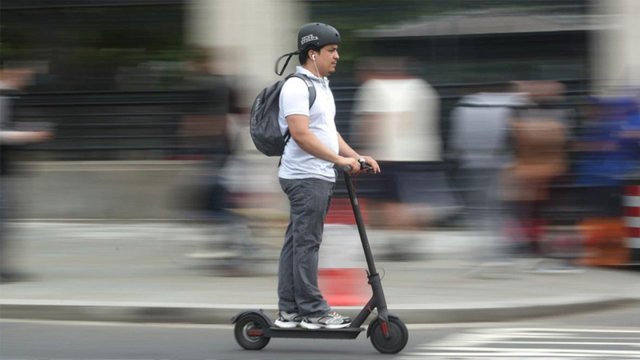THE HISTORY OF ELECTRIC SCOOTERs

Electric Scooters are a technology rapidly on the rise. The Eco-Friendly nature and convenience of their use fuels a market growing an in incredible pace across the globe. Many are unaware that modern electric scooters can trace their heritage as far back as 1895, when the first patents for electrically-powered personal transportation devices were filed. Knowing the history of electric scooters might not get you to work any faster but it’ll surely make for interesting watercooler conversation once there!
The Early Days
Technology is often invented many years before it finds mainstream interest or commercial viability. While having no direct influence on the performance of current electric scooters, it’s intriguing to understand where current models trace their lineage to. The commercial development of electric motorcycles and bikes drove the early years of this technology but as modern battery technologies advanced electric scooters quickly became (and are still becoming) popular. It can be astounding to recognize that only two decades ago the first electric scooter was invented—weighing nearly 250 pounds!
First Patent Filing
Records show that the first patent for an electric personal transport device, an electric motorcycle by chance, was filed in late 1895 by inventor Ogden Bolten Jr. of Ohio, United States. Ogden’s design is crude by today’s standards, but it was revolutionary at the time of its conception.
First Public Appearance
During this era in human history, one of the largest trade shows was the Stanley Cycle Show located in London, England. During the 1896 Cycle show, then bicycle manufacturer Humber made the first public display of a commercial electric bike. This ebike was powered by an array of batteries powering the rear wheel, and the invention was crudely controlled by a variable resistance device positioned on the handlebars.
First Publication
In October of 1911, the still riveting Popular Mechanics ran a piece covering an electric motorcycle and reported it capable of 75 miles range in a single charge, able to reach top speeds of 35 miles per hour (MPH) and able to be recharged between uses. The specifics of this device aren’t known but illustrate the era in which public awareness of electric transport begins to take form.
First Stand-Up Scooter
In early 1915 the Long-Island-based Autoped introduced their flagship product, the Autoped. This was a gasoline-powered device but marked the first commercial offering of such smaller-framed transportation devices that resemble the modern day electric kick scooters. This design was popular in New York by traffic cops at the time. The Autoped was eventually taken over by German manufacturer Krupp in 1919 but only continued production for two years.
First Electric Motorcycle Company
Sovovel Electric motorcycle company, a moniker for a very long name, was founded in 1936 by two brothers living in Brussels. This company continued production during the German occupation and found some remarkable success, for the time, due to the rationing of fuel. Unfortunately, even this unique market opportunity wasn’t enough to sway consumers away from more conventionally-powered devices after the war.
Speed Records
During the next several decades the technology of these electric-powered devices continued to evolve and diverge in different ways. The official recognition of Karl Kordesch’s electric motorcycle land speed record of 165 MPH is regarded as a historical landmark of when this alternative powered tech hit mainstream awareness among consumers.
First Commercial Scooter
The first electric scooter, available for purchase by consumers, was produced by Peugeot and made available to consumers in 1996. This revolutionary device featured a three horsepower DC motor powered by three nickel-cadmium batteries, providing a total of 18 Volts at 100Ah. This scooter weighed approximately 250 pounds and had a single-charge range of 25 miles (40 kilometers). Note: this design is for a device that falls into the category of what we’d consider a moped, not a foldable electric scooter.
The Fog Of History
The history of electric scooters is marked by many failed attempts, many lesser-known models, and often hard-to-verify details of companies that no longer exist. For example, during the same time they first motorized kick scooter, the Autoped, was introduced, the Steirische Fahrzeugwerke A.G. company also introduced the Austro Motorette near Austria. Early models of electric scooters, even up until the late nineteen-nineties, were mostly the large-form designs often referred to as mopeds. These larger designs allowed the housing of the large batteries requires for long-range operations. The surging popularity of electric kick scooters, such as the Zoom Stryder, can be attributed partly to advances in battery technology.
Looking Towards The Future
We live in exciting times. Technology is advancing at a pace that is mindboggling when compared to our history. The Digital Age is largely described in the context of smartphones, Internet technology, and computational power. One of the often-overlooked by-products of all the exciting gadgets we have today is the advances in battery technology they’ve driven. Much of these advances in consumer technology can be attributed to advances in battery technology.
Electric scooters have been limited in the past by cumbersome batteries or otherwise underperforming lead-acid designs. The advances in lithium-ion technology have offered a smaller, more powerful, longer-lasting option helping to propel foldable electric scooters to the forefront of personal transportation technology.